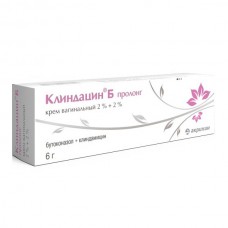Expiration date: 09/2026
Dosage form
Vaginal Cream from almost white to white with a grayish tint, with a specific smell.
Composition
100 g of cream contain:
surfactants: butoconazole nitrate in terms of 100% substance - 2 g; clindamycin phosphate in terms of 100% substance - 2,376 g, equivalent to 2g of clindamycin;
Excipients: preservative Euxyl PE 9010 (90% phenoxyethanol, 10% etilgeksilglitserol) - 0, 5 g, equivalent to 0.45 g of phenoxyethanol, propylene glycol - 5 g isopropyl myristate - 8 g tsetostearat macrogol (macrogol 20-cetostearyl ether) - 2 g
cetostearyl alcohol [60% cetyl alcohol, stearyl alcohol 40%] - 6 g, gidroksipropildikrahmalfosfat - 8 g sodium hydroxide - 0.26 g Purified water 100 g -up
pharmachologic effect
Butoconazole - imidazole derivative has fungicidal activity against fungi Candida, Trichophyton, Microsporum, Epidermaphyton and some gram-positive bacteria. Most effective for candidiasis.
Blocking in the cell membrane ergosterol formation of lanosterol that increases the permeability of the membrane, resulting in lysis of the cells of the fungus. Clindamycin - a bacteriostatic antibiotic from the group of lincosamides, broad-spectrum bladaet binds to the 50S ribosomal subunit and membrane inhibits protein synthesis in the microbial cell. In respect of a number of Gram-positive cocci possible bactericidal action.
In in vitro conditions susceptible to clindamycin following organisms that cause bacterial vaginosis: Gardnerella vaginalis, Mobiluncus spp, Mycoplasma hominis, Bacteroides spp, Peptostreptococcus spp..
The hydrophilic cream base formulation provides a gel-like consistency at a temperature of 35-40 ° C. In intravaginal application, the cream does not melt, and therefore the active agents are in the mucosa of the vagina for 1-3 days.
There is cross-resistance between clindamycin and lincomycin.
Pharmacokinetics
When administered vaginally absorbed about 1.7% of the administered dose butoconazole and 4% of the administered dose of clindamycin. The maximum concentration in plasma butoconazole achieved after 13 hours and is 2-18,6 ng / mL. Maximum concentration in the blood plasma of clindamycin is 20 ng / ml.
Butokonazol subjected to intensive metabolism, partially excreted by the kidneys and intestines.
Mode of application
Introduced intravaginally with an applicator. It used once, preferably at bedtime. The recommended dose is one full applicator (5 g of a cream, which corresponds to 100 mg of butoconazole nitrate, clindamycin and 100 mg). Treatments - daily for 3 days. For instructions on using disposable applicators supplied with the package, designed for the proper administration of the cream into the vagina. 1. Remove the cap of the tube of cream. Screw the plastic applicator on the threaded neck of the tube. 2. squeezing the tube from the opposite end, gently squeeze out the cream into the applicator. Piston applicator moves independently as required filling volume. The applicator is filled when the piston reaches its stop. 3. Lying on your back, take the applicator horizontally and introduce it into the vagina as far as possible, but so as not to cause discomfort. 4. Slowly push the plunger until it stops. 5. Carefully remove the applicator from the vagina and throw it away.
Side effects
The drug is usually well tolerated, but may cause irritation at the injection site, burning, itching, pain and swelling of the mucous membrane of the vagina, pain / cramps in the lower abdomen, the development of allergic reactions.
Special conditions
If clinical signs of infection persist after treatment, there should be repeated microbiological examination for the detection of the pathogen and confirm the diagnosis.
The appearance of the vaginal mucosa irritation or pain, an indication to stop treatment.
Vaginal Cream should not be used concurrently with other intravaginal drug.
testimony
- Bacterial, fungal and mixed vaginosis caused by drug-sensitive organisms.
Contraindications
- Crohn's disease;
- Ulcerative colitis (including history);
- Pseudomembranous colitis (including history);
- Children up to age 18;
- Hypersensitivity to clindamycin, lincomycin, butokonazol or any component of the formulation.
Precautions: allergic diseases, concomitant use of muscle relaxants.
Pregnancy and breast-feeding
Use of the drug during pregnancy and lactation is possible only if the potential benefit to the mother outweighs risk to the fetus or child.
Drug interactions
Between clindamycin and erythromycin observed antagonistic interaction.
Incompatible with solutions containing a complex of B vitamins, aminoglycosides, ampicillin, calcium gluconate and magnesium sulphate.



